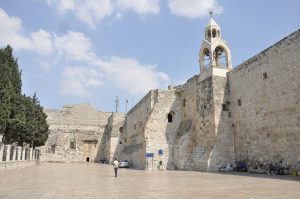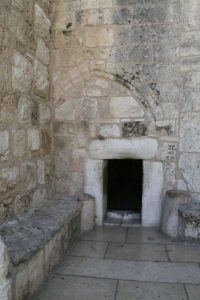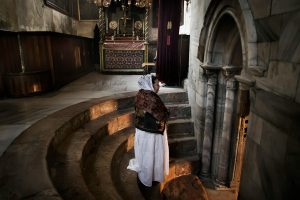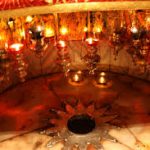2 In those days a decree went out from Emperor Augustus that all the world should be registered. 2 This was the first registration and was taken while Quirinius was governor of Syria. 3 All went to their own towns to be registered. 4 Joseph also went from the town of Nazareth in Galilee to Judea, to the city of David called Bethlehem, because he was descended from the house and family of David. 5 He went to be registered with Mary, to whom he was engaged and who was expecting a child. 6 While they were there, the time came for her to deliver her child. 7 And she gave birth to her firstborn son and wrapped him in bands of cloth, and laid him in a manger, because there was no place for them in the inn. [Luke 2:1-7, NRSV]
Armenian monastery (right) and facade of the Church of the Nativity (left, small); The Door of Humility, main entrance into the Church; Staircase to Entrance of Nativity Grotto; This fourteen-point silver star from beneath the main altar in the Grotto of the Nativity marks the traditional spot of Jesus’ birth.
Bethlehem is the town where Joseph traveled to (Luke 2:1-7) with Mary who was pregnant, and where the Lord was born (Matthew 2:1-5). Today, the city of Bethlehem, lying 10 kilometres south of the city of Jerusalem, is a leading Palestinian city in the West Bank. The city skyline displays a mix of both crescents and crosses. Visitors cannot miss the fact that the crowded city is now predominantly Muslim and no longer the little sleepy town of Christmas-carol fame. But what may not be immediately apparent to the eye is that while all Palestinians are Arabs, and most Arabs here are Muslims, not all Arabs are Muslims. Many Palestinian Arabs in Bethlehem are Christians with long Christian ancestry. Bethlehem is home to one of the oldest Christian communities in the world.
Christian Pilgrims visiting Bethlehem come to see the Church of the Nativity and the Grotto that features the spot where Jesus was born. These are housed in a complex of Nativity-related structures, the centrepiece of which is the Grotto of the Nativity, a cave which enshrines the site where Jesus is traditionally believed to have been born. It is an underground space which forms the crypt of the Church of the Nativity.
The first remarkable feature of the Church of the Nativity is the fortress-like front wall and its only doorway is a narrow and low entrance only 1.2 metres high. In fact, the previous entrance to the Church was lowered around the year 1500 to stop looters from driving their carts in. Today, very appropriately we might add, this door way becomes a door of humility so that every visitor bows low before entering the place where God humbled Himself to become man. At the entrance, we adjust our posture and stoop low, before entering the site of Christ’s birthplace.
The Church of the Nativity in Bethlehem, of basilica rank, is the oldest complete church in daily use in the Christian world, built by the emperor Justinian in the 6th century. It replaced the original church of Constantine the Great built by his mother St Helena and dedicated in AD 339. The church that continues to stand over the cave venerated as Christ’s birth place, represents an outstanding example of an early church in a remarkable architectural ensemble. Of further significance is its historical signification of the conversion of the Roman Empire to Christianity in the 4th-6th centuries AD.
While the Gospels do not record that Jesus was born in a cave, there are written references to the Nativity cave as far back as AD 160. It is common knowledge that even among the local residents in the Judean hills today, many families live in primitive houses built in front of natural caves used for storage or to shelter animals. During our visit to the shepherds’ shelters, we were shown a cave where conceivably the family lived in one section while the other section was used for storage and animal shelter especially during cold evenings. With that, it was easy to imagine Jesus being born in a stable and placed in a manger.
- Concerning the manger, it is interesting to note that when the original Church of the Nativity was built, the cave was extended to make room for pilgrims and a silver manger was installed. The latter was clearly a mistake to many thinkers, amongst whom was St Jerome who disapprovingly said: “If I could only see that manger in which the Lord lay! Now, as if to honour the Christ, we have removed the poor one and placed there a silver one; however, for me the one which was removed is more precious . . . .”
During the Persian invasion of Palestine in 614 AD, many churches were destroyed. It is remarkable that they spared the Church of the Nativity on account of the mosaic depiction of the Three Wise Men in Persian dress on one of the interior walls. The tons of lead sent by King Edward IV in 1482 for roof-renovation were looted by the Turks in the 17th century for making bullets. This caused the roof to rot and most of the rich mosaics on the walls of the nave were ruined. Since 2012, the basilica has been put on the list of UNESCO World Heritage sites as well as on its Endangered Buildings list on account of damage due to water leaks.
Another minor point of note is that while Christ’s birthday is celebrated in the Western world on December 25 of the Gregorian calendar, the church at his birthplace still has 13 days to wait for the Orthodox, using the old Julian calendar, to celebrate it on January 7. Then the Armenians celebrate Jesus’ birth and baptism together on January 19.
The place being so small and pilgrim-traffic being so heavy, our visit to the Grotto of the Nativity was another test of patience. It took so very long to get down a steep flight of steps that lead down to the subterranean cave-grotto, and even then not without some pretty “un-Christian” jostling and blocking and “standing our ground” as a group on the queue. Oh dear! It often got pretty ironical (and comical as well) when, standing in pressed queues of human bodies, we wondered how we Christians could be salt of the earth and light of the world when we behaved so aggressively to protect our queue-ground at extremely busy holy sites in Jerusalem, such as the Grotto of the Nativity and the Church of the Holy Sepulchre. As we were told previously, not only were priests from different countries leading their pilgrims to the Holy Sepulchre engaged in heated altercation, they nearly came to fist-fights as well. And so we understand and lament, that harsh and ugly realities do not only happen outside the Church, but inside it as well and, to the point, at the most holy and sacred sites of Christendom. The barbarians, we were rudely reminded, are no longer outside the walls, but inside. We are the barbarians.
The irony was amplified when we actually reached the Grotto of the Nativity.
- For far from the highly desensitized, hygienic, and picture-perfect Christmas-card image of Jesus’ birth-scene, the place of Christ’s birth is a tiny, dimly-lit rock cave. Poverty was a deafening reality. Humility is the penetrating theme here (see Philippians 2:5-11).
- Today, the rough rock of the original cave where Christmas first dawned on earth, has given way to marble facings and decorative trappings. In the words of biblical scholar E. M. Blaiklock, the cave is “hung and cluttered with all the tinsel of men’s devotions”. On feast days, as the cave is lit by 48 hanging lamps, the walls are fire-protected with heavy leather drapes and asbestos.
- Instead of a star above that led the wise men, a 14-point silver star on the marble floor of the Grotto of the Nativity bears the words “Hic de Virgine Maria Jesus Christus natus est” (Here Jesus Christ was born to the Virgin Mary). This then is the spot which Christians since at least the second century AD have traditionally identified as the beginnings of Christianity and is thus one of the holiest spots in Christendom.
- There, we knelt, bowed low, touched the silver star, and kissed the floor where the Lord was born and as quickly as possible we rose and gave way to others.
Reflection:
Christian pilgrims visiting Bethlehem are familiar with the Christmas story, so familiar in fact that we go about our Christmas celebrations mostly unconscious of our regular expectations and disappointments of the feast, its promise and heritage, and its memory and mystery. The seasonal anticipation is usually packed with assumptions, which include the retelling of an old story too familiar to mean anything touching or even serious. After all, Christmas is the celebration of the birthday of an ordinary man from an insignificant village town who had once been known as Jesus of Nazareth, the son of Mary whose husband was Joseph. Now of course, Christians across the world celebrate his birth because they accept him as “Lord and Christ”, the “Son of God” who died to save humanity from eternal doom.
It is when we intentionally pause to meditate on the Christmas events in their historical context that we begin to get a new sense of the reality surrounding the birth of Jesus – the controversy raised by the Roman census, and the sociological and cultural allusions scripted in the narrative. And then, hopefully, we may also feel an unusual impact of the Christmas story. It is good to feel a little disturbed, to awake from our spiritual slumber.
1. Luke the Historian Brings up the Census
Luke’s narrative of the birth of Christ is easily the most well-known religious story of history. Christians read more of Luke’s account during the Christmas season than any other Gospels. In it Luke sets forth the historical and central details of the birth of a babe who is the Savior of the world. To the ancient readers of Luke’s Gospel, the reference to the census meant not just a calendar date, but some serious cultural discriminations.
Cesar Augustus wanted a tax-census done. Quirinius, the Roman governor of Syria, was assigned the task of carrying out the census in the new Roman province of Judea in which Bethlehem was situated. Bethlehem being the city of David, Joseph as a descendant of the house and lineage of David had to bring his family there (Luke 2:1-5).
Originally, Bethlehem belonged to the Cannaites and was dedicated to the god of war, Lahum. The city’s name meant “the house of Lahum”. After the conquest of Palestine, the Jews revocalised the name and changed it to “lehem” which means “bread”, so Bethlehem means “house of bread”. Luke’s ancient readers understood that Jesus the Christ who is the “bread of life” (John 6:35), the “Prince of Peace” (Isa 9:6), who is “our Peace” (Eph 2:14), and the “Peacemaker” (Eph 2:15-17) came to be born in Bethlehem, the city which once meant “the house of war” and then came to mean “the house of bread”.
The fact is, according to Josephus, a Jewish historian writing in the late first century CE, Jews reacted negatively to the census. While most of them were convinced by their high priest to comply, some took up rebellion led by Judas of Galilee. Without doubt, first-century readers (or hearers) knew only too well the political implications inherent in this census. It was through and through a symbol of Roman power to which Israel was required to subordinate herself as a conquered people. Luke’s narrative speaks, then, of the political discrimination experienced by Jews under Roman rule.
Even more than discrimination and inconvenience imposed by a foreign occupying force, however, the census compromised the Jewish people’s fidelity to Yahweh.
2. Luke the Theologian Brings up the Infinitely Superior Status of Jesus
So Luke the historian wrote as a theologian at the same time. In narrating the various dramatic encounters relating to Mary’s Child, Luke stresses the life of a historical person whose life had historical and sacred significance. He introduces a counter-cultural message into a sacred story.
- Cesar Augustus is not the Divine Son; Jesus is.
- Charity and virtues too easily attributed to the Emperor paled miserably compared to Jesus who as Son of Yahweh represents Yahweh whose character is love ad mercy.
- The Peace of Rome (Pax Romana) is touted as something great, that is, so long as territories under Roman conquest agree to live in peace under Roman rule, they shall enjoy Roman protection; else, the full force and wrath of the mighty Roman military will come down as the deserved punishment on any rebellious territory. But this Roman Peace reflected in the government’s programs of freedom, security, and welfare are woefully deficient compared to the peace offered by Jesus, the Prince of Peace who brings such peace as the world cannot give. Luke is saying that into these conditions was born The One who was and is the source of true personal peace and lasting world peace, versus the temporary and false peace that man, even the very best of men of the likes that Cesar Augustus claimed to be, can give.
3. Luke the Evangelist Brings up the Concrete and Impoverished Condition of the Incarnation – the Word of God Born Poor and Marginalised
Luke amplifies the poverty and marginalization of Jesus as he narrates his birth:
- And she gave birth to her first-born son and wrapped him in swaddling cloths, and laid him in a manger, because there was no place for them in the inn (Luke 2:7).
In Jesus, God does not come as a terrorising alien power of invasion, but as a vulnerable, helpless child under greatly impoverished conditions. Jesus is born like any other baby ranked among the lowly and the poor, except that Jesus is born not at home but in a stable while on the road to an immigrant family, and laid not in a cot but in a feeding trough because the family did not have a place in the inn. Jesus may be infinitely superior, but he was not born as a descendent of a royal family. In a real,, concrete, and harsh way, at his birth, Jesus the Emmanuel (God with us) met with neither welcome nor hospitality. The Incarnation for Luke does not stay at the level of a nice idea. Instead, the Son of God has taken our human condition very seriously, so seriously that at his birth he already entered into solidarity with the Poor, the marginalized, and the suffering. He was one with them. Humility and descent open the door for solidarity and bonding.
Furthermore, Luke does not say there is anything special about Jesus at his birth at all. There is certainly no angel over the stable because the angel and crowd of heavenly hosts are over at the field, announcing the birth to the shepherds. Mary and Joseph will hear of angelic activity from the shepherds later on but, here and now, there is nothing special. The good news of great joy will come from outside, brought in by outsiders sent to meet them. At the birth of the Christ Child in Bethlehem, therefore, Luke tells us that God announces the birth to outsiders to whom the Child is born. They may have been outside for so long that they have given up on God so God sees to it that the news of the birth of the Christ Child comes to them first. When later Jesus hangs on the cross in Jerusalem, Luke will again tell us that Jesus again reaches out to an outsider who becomes a penitent thief on the cross as well, and promises him, “Truly I say to you, today you will be with me in Paradise” (Luke 23:43). The penitent outsider becomes the first to join Jesus in paradise.
This indeed is good news for Christmas, because we all know people who have been outside so long they have given up on God. We all know people so down in life that they find it hard to even want to worship. For us who are called to reach out to the Poor, the needy and the suffering, Jesus is nowhere present for them in the world if Jesus is not first present in our own hearts. The external Word of God does not really reach us if the Word is not consciously received and internalized in our hearts. Jesus Christ the Word-made-flesh is nowhere to be found in the world – not in the sumptuous Christmas dinners, the intoxicating beverages, the expensive gifts, the Christmas parties and beautiful dresses, and the scintillating neon lights of the high streets – unless he is in our hearts. There, in the depth of our hearts, we will hear Jesus speaking softly to us the Word of love that moves the world: “Go, my dear, do something for the Poor, the needy, the hurting. They need you.”
Copyright © Dr. Jeffrey & Angie Goh, December 2019. All rights reserved.
You are most welcome to respond to this post. Email your comments to jeffangiegoh@gmail.com. You can also be dialogue partners in this Ephphatha Coffee-Corner Ministry by sending us questions for discussion.




